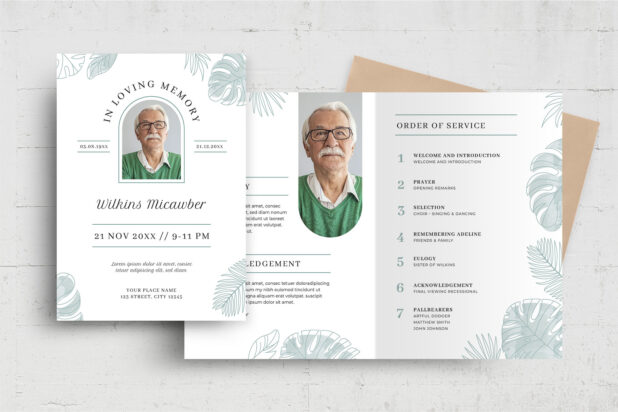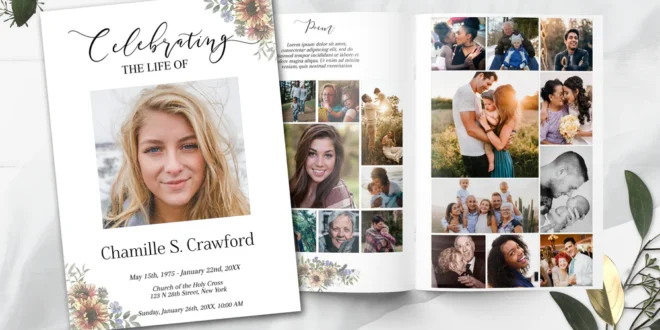When we lose a loved one, one of the ways we can pay our respects and celebrate their life is through a funeral or memorial service. A funeral program is a printed document that outlines the order of events for the service and provides information about the deceased.
Crafting a thoughtful tribute through a well-designed funeral program can help honor the memory of the deceased and provide comfort to those who attend the service.
Rosy aims to provide ideas and tips for creating a meaningful funeral program that pays tribute to your loved one. We will cover the process of gathering information, choosing the right elements, creating a structure for the program, writing the content, designing the program, and printing and distributing.
Whether you choose to use a template or create a program from scratch, this guide will help you create a heartfelt tribute that honors the life and legacy of your loved one.
Table of Contents
1. Gathering Information

Once you have decided to create a funeral program, the first step is to gather information about the deceased. This information will help you create a meaningful tribute that captures their unique personality and celebrates their life.
Start by collecting biographical information such as their full name, birth date, and place of birth. You may also want to include their parent’s names, siblings, spouses, and children. This information can be included in the introduction or biography section of the program.
Identifying important milestones in the deceased’s life can also be a helpful way to structure the program. Consider including sections such as childhood, education, career, and hobbies. Consider highlighting any significant achievements, awards, or notable moments in their life.
Finally, gathering quotes or favorite sayings can add a personal touch to the program. These can be used to introduce the program or as a closing message. You may also want to include quotes that were meaningful to the deceased or that reflect their personality and values.
Gathering information is an important first step in creating a thoughtful tribute. Take the time to reflect on the life of your loved one and consider what elements will help you create a meaningful and memorable program.
2. Choosing the Right Elements
Selecting the right elements is important in creating a meaningful funeral program. Take the time to choose elements that reflect the deceased’s personality and values, which will help create a lasting tribute. Here are some important elements to consider:
Images or photos
Selecting appropriate images or photos can help bring the program to life and visually represent the deceased. Consider using images that reflect their personality, hobbies, or favorite places. Choose high-quality images that will look clear when printed.
Font and layout
Choosing a suitable font and layout is also important. The font should be easy to read and reflect the overall tone of the program. The layout should be clear and easy to follow, with appropriate headings and subheadings. Consider using a template or working with a designer to ensure the program is easily read and visually appealing.
Symbols or colors
Incorporating meaningful symbols or colors can also add a personal touch to the program. For example, you may want to include the deceased’s favorite color or incorporate symbols that reflect their hobbies or interests. Consider including religious symbols or imagery if appropriate.
3. Creating a Structure for the Program

Creating a structure for the funeral program can help ensure that the service runs smoothly and that attendees clearly understand what to expect. Consider working with the funeral director or officiant to ensure that the program accurately reflects the order of events and provides an appropriate and meaningful tribute to the deceased. Here are some important factors to consider:
Organizing the program into sections
Consider organizing it into sections to make it easy to follow. Common sections include the introduction or biography, order of service, eulogy or tribute, and acknowledgments or thank you messages.
Deciding on the order of events
It is important to decide on the order of events for the service and incorporate this into the program. This can include music, prayers, readings, or special tributes. Consult with the funeral director or officiant to ensure that the program accurately reflects the order of events.
Including space for personal messages or reflections
Providing space for personal messages or reflections can be a meaningful way to involve attendees in the service. This can include a section for attendees to write messages or memories of the deceased or a space for family members to include their own reflections or personal messages.
4. Writing the Content

Writing the funeral program’s content requires careful consideration. Take the time to craft a meaningful and appropriate tribute that accurately reflects the life and values of the deceased.
Crafting a suitable introduction
The introduction should set the tone for the service and provide a brief overview of what attendees can expect. Consider using a quote or poem that reflects the personality or values of the deceased, or provide a brief statement about the purpose of the service.
Writing a brief biography of the deceased
The biography section should provide an overview of the life of the deceased. This can include their early years, education, career, family life, hobbies, and achievements. Be sure to highlight any unique or interesting aspects of their life to help attendees better understand and appreciate the person they are honoring.
Including poems, quotes, or other meaningful content
Including poems, quotes, or other meaningful content can add depth and emotion to the program. Consider using quotes or poems that were meaningful to the deceased or that reflect their personality or values. You may also want to include readings or other content to help attendees better understand the deceased’s life and impact on those around them.
5. Designing the Program

Designing the funeral program requires careful thought and consideration. Take the time to create a program that accurately reflects the life and values of the deceased and provides a meaningful tribute to their memory. Here are some important factors to consider:
Creating a cohesive look and feel
It is important to create a cohesive look and feel for the program that reflects the personality and values of the deceased. This can include incorporating elements such as photos, symbols, or colors that are meaningful to them.
Choosing appropriate colors and fonts
When designing the program, it is important to choose appropriate colors and fonts that are easy to read and reflect the overall tone of the service. Consider using colors and fonts consistent with the deceased’s personality and values.
Adding personal touches and customization
Adding personal touches and customization can make the program feel more special and unique. This can include incorporating special symbols or images or adding personal messages or quotes.
Final Thought
Crafting a thoughtful tribute through a funeral program is an important way to honor the life and memory of a loved one. The program provides a tangible representation of the deceased’s life and values and can serve as a meaningful keepsake for family and friends.
It is important to take the time to create a program that accurately reflects the life and values of the deceased while also providing a meaningful tribute to their memory. By gathering information, selecting appropriate elements, creating a structure, writing meaningful content, and designing the program, you can create a tribute that is both unique and personal.
Remember that this guide is just a starting point and that many ways exist to create a unique and personalized tribute. With care and attention, you can create a program that will honor the life and memory of your loved one in a way that feels true and meaningful to you.
 World Magazine 2024
World Magazine 2024






